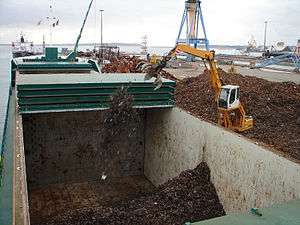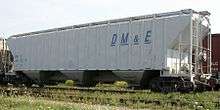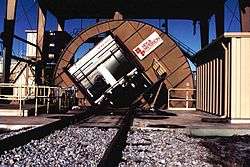Bulk cargo
Bulk cargo is commodity cargo that is transported unpackaged in large quantities.

Description
It refers to material in either liquid or granular, particulate form, as a mass of relatively small solids, such as petroleum/crude oil, grain, coal, or gravel. This cargo is usually dropped or poured, with a spout or shovel bucket, into a bulk carrier ship's hold, railroad car/railway wagon, or tanker truck/trailer/semi-trailer body. Smaller quantities (still considered "bulk") can be boxed (or drummed) and palletised. Bulk cargo is classified as liquid or dry.
The Baltic Exchange is based in London and provides a range of indices benchmarking the cost of moving bulk commodities, dry and wet, along popular routes around the seas. Some of these indices are also used to settle Freight Futures, known as FFA's. The most famous of the Baltic indices is the Baltic Dry Indices, commonly called the BDI. This is a derived function of the Baltic Capesize index (BCI), Baltic Panamax index (BPI), Baltic Supramax index (BSI) and the Baltic Handysize index (BHSI). The BDI has been used as a bellwether for the global economy as it can be interpreted as an indicator of an increase or decrease in the amount of raw commodities countries are importing/exporting.
Primary maritime cargo types
| Primary maritime cargo types | ||||
|---|---|---|---|---|
| Cargo type | Countable | Packaging | Container | Remarks |
| Break bulk cargo or general cargo | Countable | Yes | No | Break bulk cargo or general cargo are goods that must be loaded individually, and not in intermodal containers nor in bulk as with oil or grain. Ships that carry this sort of cargo are called general cargo ships. The term break bulk derives from the phrase breaking bulk—the extraction of a portion of the cargo of a ship or the beginning of the unloading process from the ship's holds. These goods may not be in shipping containers. Break bulk cargo is transported in bags, boxes, crates, drums, or barrels. Unit loads of items secured to a pallet or skid are also used.[1] |
| Bulk cargo (bulk dry cargo) | Weighable | No | No | Bulk cargo is commodity cargo that is transported unpackaged in large quantities. It refers to material in either liquid or granular, particulate form, as a mass of relatively small solids, such as petroleum/crude oil, grain, coal, or gravel. This cargo is usually dropped or poured, with a spout or shovel bucket, into a bulk carrier ship's hold, railroad car/railway wagon, or tanker truck/trailer/semi-trailer body. Smaller quantities (still considered "bulk") can be boxed (or drummed) and palletised. Bulk cargo is classified as liquid or dry. |
| Bulk liquid cargo | Weighable | No | No | A tanker (or tank ship or tankship) is a ship designed to transport or store liquids or gases in bulk. Major types of tankship include the oil tanker, the chemical tanker, and gas carrier. Tankers also carry commodities such as vegetable oils, molasses and wine. In the United States Navy and Military Sealift Command, a tanker used to refuel other ships is called an oiler (or replenishment oiler if it can also supply dry stores) but many other navies use the terms tanker and replenishment tanker. A wide range of products are carried by tankers, including:
|
| Container cargo | Countable | Yes | Yes | Containerization is a system of intermodal freight transport using intermodal containers (also called shipping containers and ISO containers).[2] The containers have standardized dimensions. They can be loaded and unloaded, stacked, transported efficiently over long distances, and transferred from one mode of transport to another—container ships, rail transport flatcars, and semi-trailer trucks—without being opened. The handling system is completely mechanized so that all handling is done with cranes [3] and special forklift trucks. All containers are numbered and tracked using computerized systems. |
| Neo-bulk cargo | Weighable | Yes | No | In the ocean shipping trade, neo-bulk cargo is a type of cargo that is a subcategory of general cargo, alongside the other subcategories of break-bulk cargo and containerized cargo.[4] (Gerhardt Muller, erstwhile professor at the United States Merchant Marine Academy and Manager of Regional Intermodal Planning of the Port Authority of New York and New Jersey, promotes it from a subcategory to being a third major category of cargo in its own right, alongside general and bulk cargo.[5][6]) It comprises goods that are prepackaged, counted as they are loaded and unloaded (as opposed to bulk cargo where individual items are not counted), not stored in containers, and transferred as units at port.[4] Types of neo-bulk cargo goods include heavy machinery, lumber, bundled steel, scrap iron, bananas, waste paper, and cars.[4][7][6] The category has only become recognized as a distinct cargo category in its own right in recent decades.[5][6] |
| Passenger cargo | Countable | No | No | A passenger ship is a merchant ship whose primary function is to carry passengers on the sea. |
| Project cargo | Weighable | Yes | No | Project cargo is a term used to broadly describe the national or international transportation of large, heavy, high value, or critical (to the project they are intended for) pieces of equipment. Also commonly referred to as heavy lift, this includes shipments made of various components which need disassembly for shipment and reassembly after delivery. |
| Refrigerated cargo | Weighable | Yes | Yes / no | A reefer ship is a refrigerated cargo ship, typically used to transport perishable commodities which require temperature-controlled transportation, such as fruit, meat, fish, vegetables, dairy products and other foods. |
| Roll-on/roll-off cargo | Countable | No | No | Roll-on/roll-off (RORO or ro-ro) ships are vessels designed to carry wheeled cargo, such as cars, trucks, semi-trailer trucks, trailers, and railroad cars, that are driven on and off the ship on their own wheels or using a platform vehicle, such as a self-propelled modular transporter. This is in contrast to lift-on/lift-off (LOLO) vessels, which use a crane to load and unload cargo. |
Dry bulk cargo ("dry" trades)[8]
- Bauxite
- Bulk minerals (sand & gravel, copper, limestone, salt, etc.)
- Cements
- Chemicals (fertilizer, plastic granules & pellets, resin powder, synthetic fiber, etc.)
- Coals and cokes
- Agricultural products such as dry edibles (for animals or humans: alfalfa pellets, citrus pellets, livestock feed, flour, peanuts, raw or refined sugar, seeds, starches, etc.)
- Grains (wheat, maize, rice, barley, oats, rye, sorghum, soybeans, etc.)
- Iron (ferrous & non-ferrous ores, ferroalloys, pig iron, scrap metal, pelletized taconite), etc.
- Wood chips
- Refrigerated goods
- Livestock and animal products
- Unitised goods
- Wheeled and heavy units
Liquid bulk cargo ("wet" trades)
Non edible and dangerous liquids
Liquid edibles and non-dangerous liquids
- Cooking oil
- Fruit juices
- Rubber
- Vegetable oil
- Zinc ash
Gallery
- A milk tank car for bulk loading.
 DME 49328, a covered hopper owned and operated by the Dakota, Minnesota and Eastern Railroad
DME 49328, a covered hopper owned and operated by the Dakota, Minnesota and Eastern Railroad
 Bulk loading of a feeder ship with rapeseed meal
Bulk loading of a feeder ship with rapeseed meal
Large ports specializing in bulk cargo
- Port of Port Hedland, Australia
- Port of Rotterdam
- Port of Vancouver
- Port of Liverpool
- Port of Tyne
- Port of Amsterdam
- Port of Hamilton (Canada)
See also
- Bulk material handling
- Covered hopper
- Flexible intermediate bulk container (bigbag)
- Harmonized System
- Hopper car
- Lake freighter
- Maritime transport
- Milk tank car
- Neo-bulk cargo
- Rotary car dumper
- Selfdischarger
- Tank car
- Tank truck
- World's busiest port
Bibliography
- Bliault, Charles; Jonas, Martin; The North of England P&I Association (2016). Bulk Cargoes: A Guide to Good Practice (First ed.). UK: The North of England P&I Association. p. 280. ISBN 978-0-9574936-3-6. ASIN 0957493630.
- George, William (2005). Stability and Trim for the Ship's Officer. Centreville, MD: Cornell Maritime Press. ISBN 978-0-87033-564-8.
- Hayler, William B.; Keever, John M. (2003). American Merchant Seaman's Manual. Cornell Maritime Pr. ISBN 0-87033-549-9.
- United Nations Conference on Trade and Development (UNCTAD) (2006). Review of Maritime Transport, 2006 (PDF). New York and Geneva: United Nations.
- United Nations Conference on Trade and Development (UNCTAD) (2007). Review of Maritime Transport, 2007 (PDF). New York and Geneva: United Nations.
References
- Notes on Cargo Work by J. F. Kemp and Peter Young, 1971 (3rd edition); page 31. ISBN 0-85309-040-8.
- Edmonds, John (2017-03-03). "The Freight Essentials: Getting Your Products Across The Ocean". Retrieved 2017-09-01.
- Lewandowski, Krzysztof (2016). "Growth in the Size of Unit Loads and Shipping Containers from Antique to WWI". Packaging Technology and Science. 29 (8–9): 451–478. doi:10.1002/pts.2231. ISSN 1099-1522.
- CambridgeSystematics 1998, pp. 79.
- Muller 1998, pp. 90.
- Muller 1995, pp. 3.
- Seyoum 2008, pp. 207.
- Dry Cargo Chartering. London: Institute of Chartered Shipbrokers. 2013. p. 38.
